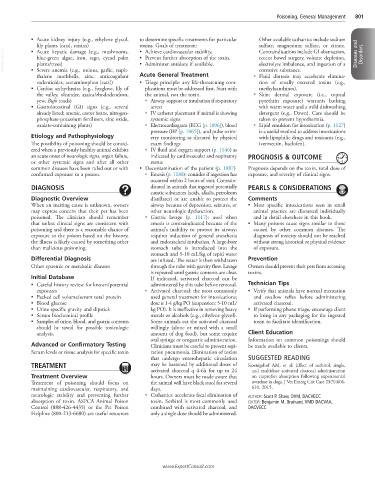Page 1593 - Cote clinical veterinary advisor dogs and cats 4th
P. 1593
Poisoning, General Management 801
• Acute kidney injury (e.g., ethylene glycol, to determine specific treatments for particular Other available cathartics include sodium
lily plants [cats], raisins) toxins. Goals of treatment: sulfate, magnesium sulfate, or citrate.
VetBooks.ir blue-green algae, iron, sago, cycad palm • Prevent further absorption of the toxin. recent bowel surgery, volume depletion, Diseases and Disorders
• Achieve cardiovascular stability.
Contraindications include GI obstruction,
• Acute hepatic damage (e.g., mushrooms,
electrolyte imbalance, and ingestion of a
plants/trees)
• Administer antidote if available.
corrosive substance.
• Severe anemia (e.g., onions, garlic, naph-
thalene mothballs, zinc, anticoagulant Acute General Treatment ○ Fluid diuresis may accelerate elimina-
rodenticides, acetaminophen [cats]) • Triage principle: any life-threatening com- tion of renally excreted toxins (e.g.,
• Cardiac arrhythmias (e.g., foxglove, lily of plications must be addressed first. Start with methylxanthines).
the valley, oleander, azalea/rhododendron, the animal, not the toxin. ○ Skin: dermal exposure (i.e., topical
yew, Bufo toads) ○ Airway support or intubation if respiratory pyrethrin exposure) warrants bathing
• Gastrointestinal (GI) signs (e.g., several arrest with warm water and a mild dishwashing
already listed; arsenic, castor beans, nitrogen- ○ IV catheter placement if animal is showing detergent (e.g., Dawn). Care should be
phosphate-potassium fertilizers, zinc oxide, systemic signs taken to prevent hypothermia.
oxalate-containing plants) ○ Electrocardiogram (ECG [p. 1096]), blood ○ Lipid emulsion for intoxication (p. 1127)
pressure (BP [p. 1065]), and pulse oxim- is a useful method to address intoxications
Etiology and Pathophysiology etry monitoring as dictated by physical with lipophilic drugs and toxicants (e.g.,
The possibility of poisoning should be consid- exam findings ivermectin, baclofen).
ered when a previously healthy animal exhibits ○ IV fluid and oxygen support (p. 1146) as
an acute onset of neurologic signs, organ failure, indicated by cardiovascular and respiratory PROGNOSIS & OUTCOME
or other systemic signs and after all other status
common diseases have been ruled out or with • Decontamination of the patient (p. 1087) Prognosis depends on the toxin, total dose of
confirmed exposure to a poison. ○ Emesis (p. 1188): consider if ingestion has exposure, and severity of clinical signs.
occurred within 2 hours of visit. Contrain-
DIAGNOSIS dicated in animals that ingested potentially PEARLS & CONSIDERATIONS
caustic substances (acids, alkalis, petroleum
Diagnostic Overview distillates) or are unable to protect the Comments
When an inciting cause is unknown, owners airway because of depression, seizures, or • Most specific intoxications seen in small
may express concern that their pet has been other neurologic dysfunction. animal practice are discussed individually
poisoned. The clinician should remember ○ Gastric lavage (p. 1117): used when and in detail elsewhere in this book.
that unless clinical signs are consistent with emesis is contraindicated because of the • Many poisons cause signs similar to those
poisoning and there is a reasonable chance of animal’s inability to protect its airway; caused by other common diseases. The
exposure to the poison based on the history, requires induction of general anesthesia diagnosis of toxicity should not be reached
the illness is likely caused by something other and endotracheal intubation. A large-bore without strong historical or physical evidence
than malicious poisoning. stomach tube is introduced into the of exposure.
stomach and 5-10 mL/kg of tepid water
Differential Diagnosis are infused. The water is then withdrawn Prevention
Other systemic or metabolic diseases through the tube with gravity flow. Lavage Owners should prevent their pets from accessing
is repeated until gastric contents are clear. toxins.
Initial Database If indicated, activated charcoal can be
• Careful history review for known/potential administered by this tube before removal. Technician Tips
exposures ○ Activated charcoal: the most commonly • Verify that animals have normal mentation
• Packed cell volume/serum total protein used general treatment for intoxications; and swallow reflex before administering
• Blood glucose dose is 1-4 g/kg PO (suspension: 5-10 mL/ activated charcoal.
• Urine specific gravity and dipstick kg PO). It is ineffective in removing heavy • If performing phone triage, encourage client
• Serum biochemical profile metals or alcohols (e.g., ethylene glycol). to bring in any packaging for the ingested
• Samples of urine, blood, and gastric contents Some animals eat the activated charcoal toxin to facilitate identification.
should be saved for possible toxicologic willingly (alone or mixed with a small
analysis. amount of dog food), but some require Client Education
oral syringe or orogastric administration. Information on common poisonings should
Advanced or Confirmatory Testing Clinicians must be careful to prevent aspi- be made available to clients.
Serum levels or tissue analysis for specific toxin ration pneumonia. Elimination of toxins
that undergo enterohepatic circulation SUGGESTED READING
TREATMENT may be hastened by additional doses of Koenigshof AM, et al: Effect of sorbitol, single,
activated charcoal q 4-6h for up to 24 and multidose activated charcoal administration
Treatment Overview hours. Owners must be made aware that on carprofen absorption following experimental
Treatment of poisoning should focus on the animal will have black stool for several overdose in dogs. J Vet Emerg Crit Care 25(5):606-
maintaining cardiovascular, respiratory, and days. 610, 2015.
neurologic stability and preventing further ○ Cathartics: accelerate fecal elimination of AUTHOR: Scott P. Shaw, DVM, DACVECC
absorption of toxin. ASPCA Animal Poison toxin. Sorbitol is most commonly used EDITOR: Benjamin M. Brainard, VMD DACVAA,
Control (888-426-4435) or the Pet Poison combined with activated charcoal, and DACVECC
Helpline (800-213-6680) are useful resources only a single dose should be administered.
www.ExpertConsult.com

